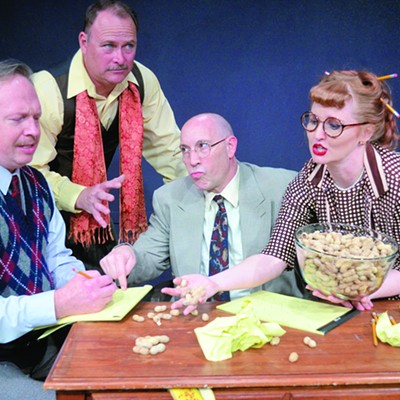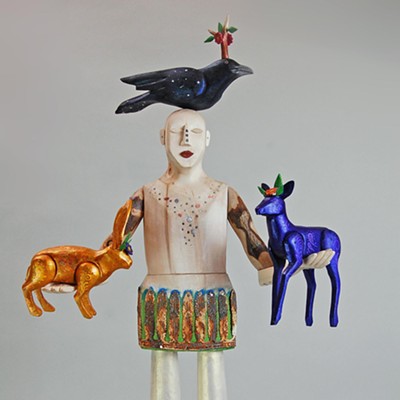Talk of the Town
Community Story Gardens: How to Grow a Neighborhood Story Program Using the Documentary Arts9 a.m. to 2 p.m., Saturday, June 12
Voices Headquarters
48 E. Pennington St.
882-5885
In Tucson, every neighborhood holds a story. When woven together, the stories of individual residents make up a fabric unique to each neighborhood, distinguishing Feldman's Neighborhood from Iron Horse and Silvercroft from Samos. Unfortunately, many of these stories--particularly those of neighborhood elders--remain unheard, hiding the vibrancy of each person's experiences and of the neighborhood itself.
The seeds of change have been sown, however, thanks to Voices: Community Stories Past and Present, Inc. The group is seeking to educate local residents on the methods, reasons and benefits of neighborhood storytelling, whether it is personal stories of individual neighbors, current neighborhood issues or neighborhood history. The stories can lead to strengthened neighborhood relationships and identities, as well as personal satisfaction.
The workshop will teach the many ways to harvest the fruits of neighborhood tales, including field work, archival research, interviews, personal essays, memoirs, poetry about place, oral history and documenting historic photographs. In turn, magazines, books, plays, dances, visual installations and murals are ways of sharing these stories with the greater community.
Be Safe
The Great Safety Adventure10 a.m. to 5 p.m., Saturday, June 12
Lowes
1800 W. Valencia Road
homesafetycouncil.org
Over the years, children have been guided in their activities by fictional safety mavens such as Smokey Bear, Captain Hydro and Susie Safety, to name a few. In my elementary school, we even had posters featuring a weird, anthropomorphic state-of-California-shaped fellow who sternly warned us that "The Big One" was going to shake us into oblivion sooner or later. It seems that these super-human (or semi-human) guardians of late have abandoned their muggish scare tactics for a more interesting--even fun--role with kids. Take Rover, the Home Safety Hound, for example.
Rover, that benevolent pal, accompanies children and their parents through the Great Safety Adventure, a 1,200-square-foot "field trip on wheels." Built upon and around two semi-tractor trucks, it is a life-size replica of a living room, kitchen, bathroom, bedroom and backyard. Kids and parents are transformed into "safety rangers" as they scour the house for common safety hazards. The main dangers the program focuses on are fires and burns, poisonings, choking and suffocation, and slips and falls. When a hazard is identified, the child is prompted to say, "Code Red Rover, Grown-Up Come Over." It may not be as much fun as the original Red Rover game, but it's a heck of a lot safer.
The Great Safety Adventure was created by the nonprofit Home Safety Council, which seeks to help prevent accidents in the home. The program visits local schools this month and makes public appearances, such as this week's stop at Lowe's. Visit homesafetycouncil.org for details.
¡Tequila!
A Toast to Gary Paul Nabhan and Tequila4 p.m. to 6 p.m., Saturday, June 12
J Bar at Westin La Paloma
3770 E. Sunrise Drive
621-3920
And on a completely different note ... how about that tequila? A popular libation in our borderlands region, the warming liquid, made from the blue agave, is either adored or despised. But those who love it, really love it--enough to co-write a book about it, as ethnobotanist, co-founder of Native Seeds/SEARCH and Macarthur fellow Gary Paul Nabhan has recently done.
¡Tequila! A Natural and Cultural History discusses the drink, the plant and the people who have utilized it over the years. The drink has more claims to fame than just being the key ingredient in that pitcher of margaritas you're holding. In ¡Tequila!, Nabhan reveals the secret past of the fiery beverage.
UA Press, J Bar and the local chapter of Slow Food USA have conspired to host a meet-and-greet for Nabhan, including slow food hors d'oeuvres, fine heritage tequila samples and other beverages (there's an additional charge for the drinks). Copies of the book will be available for purchase and signing.
Admission is $10, and includes slow food/heritage hors d'oeuvres. For more information, see page 37.
Museum Is Contemporary Art
Tomorrow's MOCA: New Voices/New VisionsNoon to 9 p.m., Saturday, June 12
Downtown Arts Festival/Art In The City
197 E. Toole St.
624-5019
Along with the snowbirds, college students and part-time desert rats, another Tucson resident will be absent this summer. The Museum of Contemporary Art is closing its doors for the summer, but before they lock up, they're having one last bash in conjunction with Art in the City, downtown Tucson's art festival this weekend.
Months of investigation, research and creativity have yielded a melting pot of design and renovation ideas for the museum. Students and faculty from the University of Arizona's Preservation Studies Program in the College of Architecture and Landscape Architecture have worked on this real-life design case study. This Saturday evening, the plans will be put on display for all of Tucson to see.
This exciting new glimpse into the future of MOCA includes architectural preservation as a key point, including examples of old warehouses transformed into major contemporary art centers, a project undertaken by several cities around the nation. Uniqueness is key, though; as MOCA Board Member Rick Joy, an architect and UA College of Agriculture graduate, said in a meeting, "We don't want this to be just another MOCA; this is MOCA Tucson!"
Admission is free.







